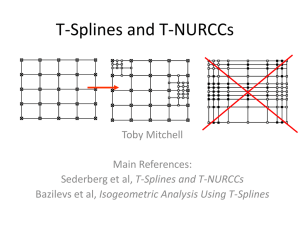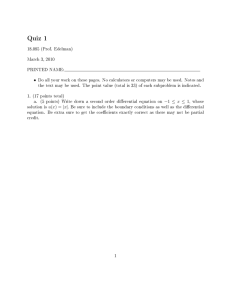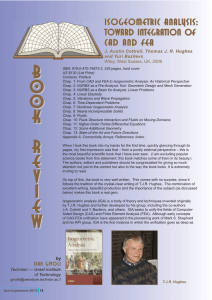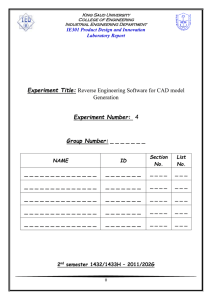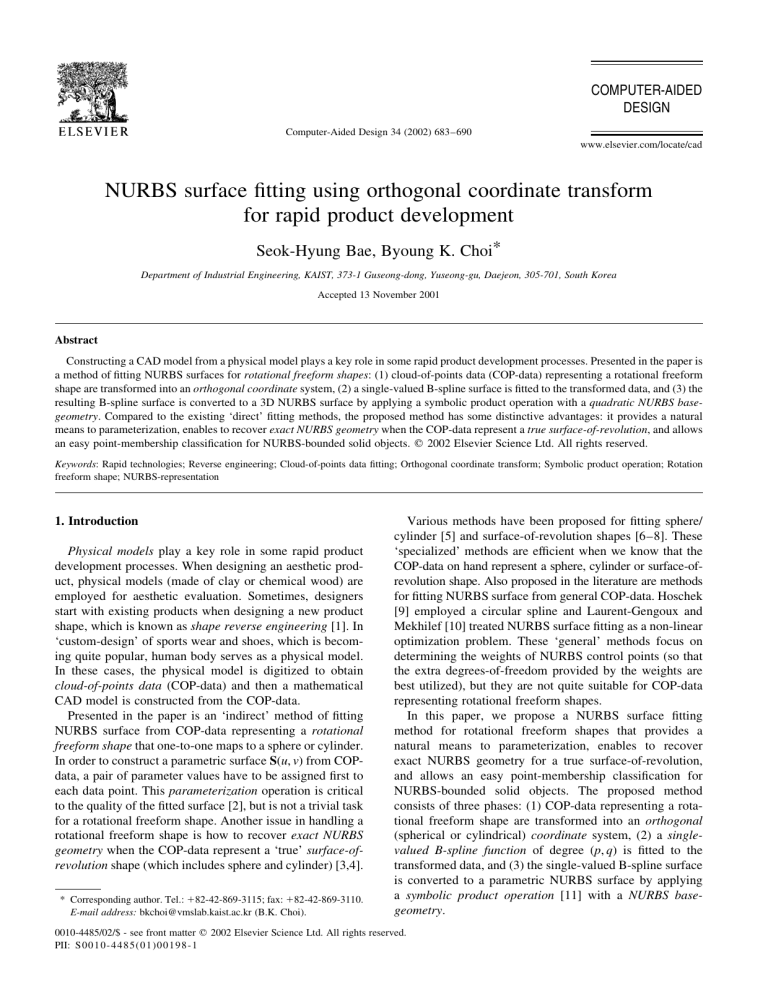
COMPUTER-AIDED
DESIGN
Computer-Aided Design 34 (2002) 683±690
www.elsevier.com/locate/cad
NURBS surface ®tting using orthogonal coordinate transform
for rapid product development
Seok-Hyung Bae, Byoung K. Choi*
Department of Industrial Engineering, KAIST, 373-1 Guseong-dong, Yuseong-gu, Daejeon, 305-701, South Korea
Accepted 13 November 2001
Abstract
Constructing a CAD model from a physical model plays a key role in some rapid product development processes. Presented in the paper is
a method of ®tting NURBS surfaces for rotational freeform shapes: (1) cloud-of-points data (COP-data) representing a rotational freeform
shape are transformed into an orthogonal coordinate system, (2) a single-valued B-spline surface is ®tted to the transformed data, and (3) the
resulting B-spline surface is converted to a 3D NURBS surface by applying a symbolic product operation with a quadratic NURBS basegeometry. Compared to the existing `direct' ®tting methods, the proposed method has some distinctive advantages: it provides a natural
means to parameterization, enables to recover exact NURBS geometry when the COP-data represent a true surface-of-revolution, and allows
an easy point-membership classi®cation for NURBS-bounded solid objects. q 2002 Elsevier Science Ltd. All rights reserved.
Keywords: Rapid technologies; Reverse engineering; Cloud-of-points data ®tting; Orthogonal coordinate transform; Symbolic product operation; Rotation
freeform shape; NURBS-representation
1. Introduction
Physical models play a key role in some rapid product
development processes. When designing an aesthetic product, physical models (made of clay or chemical wood) are
employed for aesthetic evaluation. Sometimes, designers
start with existing products when designing a new product
shape, which is known as shape reverse engineering [1]. In
`custom-design' of sports wear and shoes, which is becoming quite popular, human body serves as a physical model.
In these cases, the physical model is digitized to obtain
cloud-of-points data (COP-data) and then a mathematical
CAD model is constructed from the COP-data.
Presented in the paper is an `indirect' method of ®tting
NURBS surface from COP-data representing a rotational
freeform shape that one-to-one maps to a sphere or cylinder.
In order to construct a parametric surface S u; v from COPdata, a pair of parameter values have to be assigned ®rst to
each data point. This parameterization operation is critical
to the quality of the ®tted surface [2], but is not a trivial task
for a rotational freeform shape. Another issue in handling a
rotational freeform shape is how to recover exact NURBS
geometry when the COP-data represent a `true' surface-ofrevolution shape (which includes sphere and cylinder) [3,4].
* Corresponding author. Tel.: 182-42-869-3115; fax: 182-42-869-3110.
E-mail address: bkchoi@vmslab.kaist.ac.kr (B.K. Choi).
Various methods have been proposed for ®tting sphere/
cylinder [5] and surface-of-revolution shapes [6±8]. These
`specialized' methods are ef®cient when we know that the
COP-data on hand represent a sphere, cylinder or surface-ofrevolution shape. Also proposed in the literature are methods
for ®tting NURBS surface from general COP-data. Hoschek
[9] employed a circular spline and Laurent-Gengoux and
Mekhilef [10] treated NURBS surface ®tting as a non-linear
optimization problem. These `general' methods focus on
determining the weights of NURBS control points (so that
the extra degrees-of-freedom provided by the weights are
best utilized), but they are not quite suitable for COP-data
representing rotational freeform shapes.
In this paper, we propose a NURBS surface ®tting
method for rotational freeform shapes that provides a
natural means to parameterization, enables to recover
exact NURBS geometry for a true surface-of-revolution,
and allows an easy point-membership classi®cation for
NURBS-bounded solid objects. The proposed method
consists of three phases: (1) COP-data representing a rotational freeform shape are transformed into an orthogonal
(spherical or cylindrical) coordinate system, (2) a singlevalued B-spline function of degree p; q is ®tted to the
transformed data, and (3) the single-valued B-spline surface
is converted to a parametric NURBS surface by applying
a symbolic product operation [11] with a NURBS basegeometry.
0010-4485/02/$ - see front matter q 2002 Elsevier Science Ltd. All rights reserved.
PII: S 0010-448 5(01)00198-1
684
S.-H. Bae, B.K. Choi / Computer-Aided Design 34 (2002) 683±690
2.1. Basic idea
u cos u; sin u denote a unit circle centered at
Let B
the origin of a xy-coordinate system, then a rotational freeform curve C(u ) on the xy-plane may be expressed as a
u and a single-valued function F(u ) as
product of B
follows:
u F ucos u; F usin u
C u ; x u; y u F uB
1
Fig. 1. (a) A single-valued function in polar coordinates, and (b) its corresponding 2D parametric curve in xy-coordinate system.
When the ®tted NURBS surface becomes a face of a
NURBS-bounded solid object, the single-valued B-spline
surface may be used as a point-membership classi®er.
Namely, a 3D point to be classi®ed is transformed into the
orthogonal coordinate system of the ®tted NURBS surface
and its `range' value is compared against the single-valued
B-spline surface. Point-membership classi®cation for a
general NURBS-bounded solid object is not a trivial operation [12]. Point-membership classi®cation for rotational
freeform shapes has been studied quite extensively by
Sanchez-Reyes [13±16]. The Sanchez-Reyes' method,
which uses a sinusoidal spline function as the basis function,
is similar to the method proposed in the paper and may be
used as a NURBS surface ®tting method for a sphere-like
shape (but not for cylinder-like shape because its singlevalued function is not a tensor product surface).
The organization of the paper is as follows: described in
Section 2 is a NURBS curve ®tting method using polar
coordinate transform, which is the core procedure for the
NURBS surface ®tting methods to be presented in Section 3.
Also presented in Section 3 are special treatments and a
method for estimating local coordinate systems. Illustrative
examples are given in Section 4, and Section 5 closes the
paper with discussions and conclusions.
2. NURBS curve ®tting procedure
The NURBS curve ®tting method, which becomes the
core part of the NURBS surface ®tting method of Section
3, is based on polar coordinate transformation of 2D points
representing a circle-like curve (i.e. rotational freeform
curve).
Fig. 2. Base circle construction for cross-sectional data points.
u is called a (trigonometric) base
where the unit circle B
circle. A construction for the above relationship is shown in
Fig. 1.
A sequence of 2D points { xk ; yk } representing a rotational freeform curve may be ®tted to the curve C(u ) in Eq.
(1) as follows:
1. { xk ; yk } is converted into a polar-coordinate pointsequence { rk ; uk }:
2. { rk ; uk } is ®tted to a single-valued B-spline function
r F u:
3. F(u ) is converted to a 2D curve C(u ) using Eq. (1).
u in Eq. (1)
By replacing the trigonometric base-circle B
with a NURBS base-circle B(u) we can obtain a NURBS
curve C(u). However, for this replacement to work properly,
we need a parameter-synchronization between u and u. The
NURBS base-circle B(u) may consist of four rational quadratic Bezier curves (RQB-curves) [3] and it does not have a
uniform ¯ow rate [17]. Now we present our NURBS curve
®tting procedure.
2.2. NURBS curve ®tting procedure
The overall procedure for ®tting a 2D NURBS curve from
a sequence of 2D points { xk ; yk } consists of ®ve steps: (1)
polar coordinate transform, (2) base circle construction, (3)
parameter synchronization, (4) single-valued B-spline curve
®tting, and (5) NURBS curve construction.
Step 1: Polar coordinate transform
A sequence of points { xk ; yk } in 2D Cartesian coordinates are converted into a polar-coordinate point-sequence
{ rk ; uk } as follows:
q
rk x2k 1 y2k ;
8 21
>
tan yk =xk
if xk . 0 and yk $ 0
>
<
uk p 1 tan21 yk =xk if xk , 0
>
>
:
2p 1 tan21 yk =xk if xk . 0 and yk , 0
2
Step 2: Base circle construction
A base circle B(u) having an arc angle of ue 2 us is easily
obtained by using the square-based method [18,19], where a
full circle is de®ned by four RQB-curves. Shown in Fig. 2 is
a sequence of polar coordinate points { rk ; uk } inside an
S.-H. Bae, B.K. Choi / Computer-Aided Design 34 (2002) 683±690
685
In practice, an RQB-curve is de®ned over a unit interval so
that u je j; u js j 2 1; in which case Eq. (6) reduces to uk
hk 1 j 2 1:
Shown in Fig. 3(a) is a construction for ®nding the intersection parameter h k between B1 h and the line joining the
coordinate origin and C k xk ; yk : The relation between h k
and j k is depicted in Fig. 3(b).
Fig. 3. Geometric construction for parameter synchronization (i.e. ®nding
hk ).
angle range of us ; ue ; where the base circle B(u) consists of
three RQB-curves since the arc angle is less than 3p/2 (but
larger than p). Observe that the control polygon of the base
circle B(u) is also shown in the ®gure.
Step 3: Curve parameter synchronization
The synchronized parameter value uk of the base
circle B(u) for a polar-coordinate point rk ; uk corresponds
to the intersection point between B(u) and the line joining the
origin and the 2D-Cartesian point C k xk ; yk : To ®nd uk at
the intersection-point, B(u) is ®rst decomposed into individual RQB-curves {Bj h} for u [ u js ; u je : Now, a local
parameter for each RQB-curve is de®ned as
h
i
3
u [ u js ; u je :
h u 2 u js = uje 2 u js ;
Then, the local parameter value h k for a polar-coordinate
point rk ; uk within the angle range u js ; u je may be obtained
from the following relation:
cos uk ; sin uk Bj h
4
A solution to Eq. (4) is given by [20]
tan
jk
2
;
hk p
j
1 2 w2 1 1 2 wtan k
2
j k uk 2 u js
5
where w is the weight of the middle control point of the RQBcurve Bj h: Finally, the synchronized parameter value for
rk ; uk belonging to Bj h is obtained from the following
equation:
uk u je 2 u js hk 1 u js
6
Step 4: Single-valued B-spline curve ®tting
A single-valued B-spline curve F(u) of degree p (usually
p 3) is ®tted to the parameter-synchronized points
{ r k ; uk } by using standard ®tting methods [19,21±24].
F u
nF
X
i0
Ni;p ufi ;
UF { us ; ¼; us ; up11 ; ¼; unF ; ue ; ¼; ue }
|{z}
|{z}
p11
7
p11
Step 5: NURBS curve construction
At the ®nal step, a parametric NURBS curve is constructed
from the single-valued B-spline curve F(u) by applying a
symbolic product operation [11] with the NURBS base circle
B(u). Namely, from C u F uB u we have
nC
X
C u
Ni;p12 uwi Pi
i0
nC
X
i0
;
Ni;p12 uwi
8
UC { us ; ¼; us ; up1211 ; ¼; unC ; ue ; ¼; ue }
|{z}
|{z}
p1211
p1211
where Ni;p12 u is a B-spline basis function of degree p 1 2, wi
is a weight, and Pi is a control point of the NURBS curve C(u).
The above NURBS curve construction concept is illustrated in
Fig. 4, where the degree of F(u) is 3 and that of the resulting
NURBS curve is 5.
If the 2D point sequence { xk ; yk } represents a true circle
of radius R, the single-valued B-spline curve will become a
constant line, namely, F u R: In this case, the degree of
F(u) is zero p 0 so that the degree of the resulting
NURBS curve becomes 2. That is, C u RB u becomes
a true circle of radius R.
Fig. 4. NURBS curve construction via symbolic product operation.
686
S.-H. Bae, B.K. Choi / Computer-Aided Design 34 (2002) 683±690
And, the angle ranges are computed as
fs min{fk };
fe max{fk };
us min{uk };
ue max{uk }:
Step 2: Base sphere construction
A unit sphere de®ned over the angle ranges fs ; fe and
us ; ue is chosen as the base sphere B u; v; which is a
NURBS surface consisting of up to (2 £ 4) RQB patches
depending on arc angles fe 2 fs and ue 2 us [3].
Fig. 5. Geometric construction for parameter synchronization for spherical
NURBS surface ®tting (i.e. ®nding vk and uk).
3. NURBS surface ®tting procedure
The procedure for ®tting a NURBS surface from COPdata is similar to the curve ®tting procedure given in Section
2.2, and consists of ®ve steps: (1) orthogonal coordinate
transform, (2) base geometry construction, (3) parameter
synchronization, (4) single-valued B-spline surface ®tting,
and (5) NURBS surface construction. A rotational freeform
shape may be one-to-one mapped to a sphere or a cylinder:
when the shape is more naturally mapped to a sphere, a
spherical NURBS surface is ®tted from the COP-data.
3.1. Spherical NURBS surface ®tting
Step 1: Spherical coordinate transform
The COP-data { xk ; yk ; zk } representing a sphere-like
shape are converted into spherical coordinate points
{ rk ; fk ; uk } as follows:
q
rk x2k 1 y2k 1 z2k ;
q
fk cos21 zk = x2k 1 y2k 1 z2k ;
8 21
>
tan yk =xk
>
<
uk p 1 tan21 yk =xk
>
>
:
2p 1 tan21 yk =xk
Step 4: Single-valued B-spline surface ®tting
A single-valued B-spline surface F u; v of degree p; q
is now ®tted to the parameter-synchronized points
{ rk ; uk ; vk } by using standard ®tting methods [19,21±24].
F u; v
nF X
mF
X
i0 j0
(9)
if xk . 0 and yk , 0
Ni;p uNi;q vfi; j ;
UF { us ; ¼; us ; up11 ; ¼; unF ; ue ; ¼; ue };
|{z}
|{z}
p11
if xk . 0 and yk $ 0
if xk , 0
Step 3: Parameter synchronization
Similar to the curve ®tting case, ®nding the synchronized
parameter values of the base surface B u; v for a spherical
coordinate point rk ; fk ; uk is equivalent to ®nding an intersection point between B u; v and the line joining the origin
and the 3D-Cartesian point C k xk ; yk ; zk : Since the base
sphere B u; v is constructed by a surface-of-revolution
method [3], synchronized parameter values uk and vk can be
calculated separately by using the curve parameter synchronization method (Step 3) described in Section 2.2. As depicted in
Fig. 5(a), vk is obtained from C(v) and C kp xk ; yk ; 0; where
C kp xk ; yk ; 0 is the projection point of C k xk ; yk ; zk on the xyplane and C(v) is a NURBS base circle on the xy-plane with an
arc angle ue 2 us : Once vk is determined, another base circle
D u B u; vk is de®ned as depicted in Fig. 5(b), and then, uk
is calculated from D(u) and C k xk ; yk ; zk :
p11
10
VF { vs ; ¼; vs ; vq11 ; ¼; vmF ; ve ; ¼; ve }
|{z}
|{z}
q11
q11
Step 5: NURBS surface construction
Finally, a parametric NURBS surface S u; v is constructed from the single-valued B-spline surface F u; v by
applying a symbolic product operation with the NURBS
base sphere B u; v: That is, S u; v F u; vB u; v having
a tensor product form of the NURBS curve in Eq. (8), where
the degrees of the resulting NURBS surface are p 1 2; q 1
2: Shown in Fig. 6(a) is a bi-cubic B-spline function (i.e.
p q 3) for the parameter-synchronized points and the
resulting NURBS surface of degree (5,5) obtained from
NURBS surface conversion is shown in Fig. 6(b).
3.2. Cylindrical NURBS surface ®tting
Fig. 6. NURBS surface obtained by spherical NURBS surface ®tting.
When the rotational freeform shape is more naturally
mapped to a cylinder, a cylindrical NURBS surface is ®tted
S.-H. Bae, B.K. Choi / Computer-Aided Design 34 (2002) 683±690
687
When the degrees of F u; v are p; q; it can be shown
that the degrees of the resulting NURBS surface S u; v are
max{p; 1}; q 1 2: For COP-data representing a true
surface-of-revolution, the degrees of F u; v would be
(3,0). Thus, the degrees of S u; v are (3,2). For a true
cylindrical shape, the degrees of S u; v become (1,2).
3.3. Special treatments
Fig. 7. NURBS surface obtained by cylindrical NURBS surface ®tting.
from the COP-data. The procedure is basically the same as
that of the spherical case described in Section 3.1.
First, 3D points { xk ; yk ; zk } are transformed into cylindrical coordinate points { rk ; uk ; zk } and a cylinder with unit
radius is used as a base cylinder B u; v which is a NURBS
surface of degree (1,2). Parameter-synchronization is carried
out as follows: as with the spherical case, vk is obtained by
using the curve parameter synchronization method of Section
2.2 as depicted in Fig. 7(a), and uk is given by uk zk 2
zs = ze 2 zs : And then, a single-valued bi-cubic B-spline
surface F u; v is ®tted as with the spherical case. Finally, a
3D NURBS surface S u; v is given by:
nS X
mS
X
S u; v
Ni;3 uNj;5 vwi; j Pi; j
i0 j0
nS X
mS
X
i0 j0
;
Ni;3 uNj;5 vwi; j
US { us ; ¼; us ; u311 ; ¼; unS ; ue ; ¼; ue };
|{z}
|{z}
311
11
311
VS { vs ; ¼; vs ; v511 ; ¼; vmS ; ve ; ¼; ve }
|{z}
|{z}
511
511
Shown in Fig. 7(b) is the resulting NURBS surface of degree
(3,5) for the COP-data of Fig. 7(a).
When a `closed' surface is to be constructed, periodic
B-spline basis functions [25] have to be employed in the
v-direction (corresponding to u ) of F u; v during the
single-valued B-spline surface ®tting stage.
A special treatment is also required to solve the `degeneracy problem' when ®tting a spherical NURBS surface. In
order to smoothly ®ll the `hole' near the pole of the base
sphere (see Fig. 8(a)), the following continuity conditions
must be imposed on the control points of the B-spline
function
f0; j f0;0 ;
j 1; ¼; mF
12
f1; j f0; j ;
j 0; ¼; mF
13
Shown in Fig. 8(b) is the resulting NURBS surface satisfying G 1 continuity condition.
3.4. Local coordinate system estimation
The proposed NURBS surface ®tting method requires
that the COP-data in a global Cartesian coordinate system
be transformed to a local Cartesian coordinate system
where the orthogonal coordinates are de®ned. This in turn
requires a robust estimation of local coordinate system from
the original COP-data. For the purpose, principal component analysis (PCA) [26,27], which is also known as
Karhunen±Loeve transform, is widely used in the ®eld of
image processing and computer vision. PCA works well for
COP-data of the whole of a rotational freeform shape, but
not for those of a part because it ®nds the local coordinate
system de®ning the oriented bounding box of the COP-data.
Presented in this sub-section is a local coordinate system
Fig. 8. Cloud-of-points data of sphere-like part with degeneracy problem and resulting NURBS surface with G 1 continuity at degenerate point.
688
S.-H. Bae, B.K. Choi / Computer-Aided Design 34 (2002) 683±690
origin o) can be uniquely determined from the subdiscriminant matrix Qu : The z-axis vector k is set to the eigenvector having the smallest eigenvalue [31]. Thus, the
rotational axis of a surface-of-revolution shape becomes
the eigenvector with the smallest eigenvalue.
And, the origin o of the local coordinate system is determined from the following relation:
2Qu x 1 v 0
15
In the case of rank Qu 3 (real ellipsoid, hyperboloid of
one sheet, hyperboloid of two sheets, and real quadric cone),
the origin o is given by [28,32]
1
o 2 Q21
v
2 u
16
For rank Qu 2 (elliptic paraboloid and real elliptic cylinder),
the origin of the local coordinate is given by (see Appendix
A):
o p 1 t0 q
17
The local coordinate estimation method was applied to a set
of COP-data obtained by `virtually digitizing' spheres and
cylinders with different values of radius R (cylinders' length
is set to 2R). Random noises sampled from normal distribution N 0; s 2 were added to the x-, y-, z-components of the
COP-data points. Shown in Fig. 9(a) are relative origin
estimation errors (in %) plotted against the normalized
maximum noise NM =R (for the sphere COP-data), where
NM 3s: The z-axis estimation errors (in degrees) plotted
against N M =R are shown in Fig. 9(b) (for the cylinder COPdata).
Fig. 9. Empirical results of local coordinate system estimation.
4. Illustrative examples
estimation method based on the least squares approximation method proposed by Faugeras and Hebert [28].
A general quadric surface is a second-degree algebraic
surface having the following matrix form:
2 3
x
6 7
T
T
7
x;6
q x x Qu x 1 v x 1 d 0;
4 y 5;
2
q1
6
Qu ; 6
4 q4 =2
q4 =2
q2
q6 =2 q5 =2
q6 =2
3
7
q5 =2 7
5;
q3
z
2 3
q7
6 7
7
v;6
4 q8 5;
d q10
q9
14
Quadric surface may be classi®ed into different types based
on its coef®cients [29,30] and the following six types are
relevant to local coordinate system estimation: real ellipsoid, hyperboloid of one sheet, hyperboloid of two sheets,
real quadric cone, elliptic paraboloid, real elliptic cylinder.
Namely, when COP-data are ®tted to one of the six quadric
surface types, its coordinate frame (i.e. z-axis vector k and
The proposed NURBS surface ®tting methods were
applied to different types of COP-data. Shown in Fig.
10(a) are COP-data for a traditional Korean ceramic. Also
shown are the approximated quadric surface (real ellipse)
and the estimated local coordinate system (x-, y-axis are
arbitrarily chosen). The ®tted NURBS surface together
with its control points for the COP-data of Fig. 10(a) is
shown in Fig. 10(c). Observe from the control points that
the degrees of the resulting NURBS surface are (3,2). This is
expected since the ceramic is a `true' surface-of-revolution
shape. Now, the COP-data of Fig. 10(a) are scaled down
(0.75) along the y-direction to obtain a rotational freeform
shape as shown in Fig. 10(b). Also shown in Fig. 10(b) are
the approximated quadric surface and its local coordinate
system. The ®tted NURBS surface of degrees (3,5) and its
control points are shown in Fig. 10(d).
Shown in Fig. 11(a) are COP-data for an auto-gearshift
knob obtained from a coordinate measuring machine
(CMM). The initial COP-data were split into two data sets
(de®ned on the same coordinate system of Fig. 11(a)): upper
(head) data and lower (neck) data. The `head' COP-data
were ®tted to spherical NURBS surface and the `neck'
S.-H. Bae, B.K. Choi / Computer-Aided Design 34 (2002) 683±690
689
Fig. 11. Surface modeling for auto-gearshift knob data.
Fig. 10. NURBS surface ®tting for traditional Korean ceramic.
COP-data to cylindrical NURBS surface, and then the two
NURBS surfaces are joined together as shown in Fig. 11(b).
In order to achieve G 1 continuity between the two surfaces,
the control points near the common boundary have to be
`corrected' (this is an important issue by itself, but will not
be discussed in this paper). A shaded image and facet model
(for rapid prototyping) of the joined NURBS surface are
shown in Fig. 11(c) and (d), respectively.
5. Discussions and conclusions
The proposed NURBS surface ®tting method may be
dubbed as an `indirect' method because it differs from the
existing `direct' methods where a 3D B-spline surface is
constructed `directly' from COP-data. The proposed method
provides a natural means to assign parameter values to
COP-data representing a rotational freeform shape, and
may be embedded in a laser scanner having a spherical or
cylindrical kinematics structure (because the laser scanner
generates range data in its orthogonal coordinate system).
The proposed method enables to recover an exact NURBS
surface for COP-data sampled from a true surface-ofrevolution shape. The proposed method allows the
NURBS surface to be stored as a single-valued function,
which requires less memory and, more importantly, it
allows an easier point-membership classi®cation for
NURBS-bounded solid objects.
A major drawback of the proposed method is that the
degrees of the resulting NURBS surface are somewhat
high. For example, if a bi-cubic B-spline function is used
in the single-valued function ®tting stage, the degrees of the
spherical NURBS surface are (5, 5).
Acknowledgements
The Ministry of Science and Technology of Korean
government has supported the research.
Appendix A. Origin of local coordinate system when
rank Qu 2
Let A 2Qu and b 2v; then Eq. (15) can be written in
a matrix form as follows:
Ax b
A1
When rank A 2; a general solution of Eq. (A1) is given by
x p 1 tq;
t[R
A2
where p is a particular solution of Ax b; and the unit
vector q is a solution set of Ax 0: p, q are calculated
using the singular value decomposition method [33]. In
order to obtain the origin o of the local coordinate system
690
S.-H. Bae, B.K. Choi / Computer-Aided Design 34 (2002) 683±690
for the input COP-data {C k xk ; yk ; zk ; k 1; ¼; N}, t is
determined so that the following objective function is
minimized:
f t
N
X
k1
C k 2 o2
N
X
k1
{C k 2 p 1 tq}2
A3
Thus, the value of t satisfying df t=dt 0 is obtained as
follows:
t0
N
1 X
q´
C k 2 p
N k1
A4
References
[1] Varady T, Martin RR, Cox J. Reverse engineering of geometric
modelsÐan introduction. Comput-Aided Des 1997;29(4):255±68.
[2] Ma W, Kruth JP. Parameterization of randomly measured points for
least squares ®tting of B-spline curves and surfaces. Comput-Aided
Des 1995;27(9):663±75.
[3] Piegl L, Tiller W. Curve and surface constructions using rational Bsplines. Comput-Aided Des 1987;19(9):485±98.
[4] Piegl L. On NURBS: a survey. IEEE Comput Graphics Appl 1991;
10(1):55±71.
[5] Lukacs G, Marshall AD, Martin RR. Geometric least-squares ®tting
of spheres, cylinders, cones and tori. In: Martin RR, Varady T, editors,
RECCAD deliverable documents 2 and 3 Copernicus project no.
1068: reports on basic geometry and geometric model creation, etc.
Report GML 1997/5, Computer and Automation Institute, Hungarian
Academy of Sciences, Budapest, 1997.
[6] Pottmann H, Randrup T. Rotational and helical surface approximation
for reverse engineering. Computing 1998;60:307±22.
[7] Pottmann H, Chen HY, Lee IK. Approximation by pro®le surface. In:
Cripps R, editor. The mathematics of surfaces VIII, Information
Geometers, 1998. p. 17±36.
[8] Lai JY, Ueng WD. Reconstruction of surfaces of revolution from
measured points. Comput Ind 2000;41:147±61.
[9] Hoschek J. Circular splines. Comput-Aided Des 1992;24(11):611±8.
[10] Laurent-Gengoux P, Mekhilef M. Optimization of a NURBS representation. Comput-Aided Des 1993;25(11):699±710.
Seok-Hyung Bae is a PhD candidate in the
Department of Industrial Engineering at
Korea Advanced Institute of Science and Technology. He received a BS and an MS in
Mechanical Engineering from KAIST in
1994 and 1996, respectively. His research
interests are in the area of surface modeling,
CAD/CAM, and reverse engineering.
[11] Piegl L, Tiller W. Symbolic operators for NURBS. Comput-Aided
Des 1997;29(5):361±8.
[12] Nielson G. CAGD's top ten: what to watch. IEEE Comput Graphics
Appl 1993;13(1):35±7.
[13] Sanchez-Reyes J. Single-valued curves in polar coordinates. ComputAided Des 1990;22(1):19±26.
[14] Sanchez-Reyes J. Single-valued surfaces in cylindrical coordinates.
Comput-Aided Des 1991;23(8):561±8.
[15] Sanchez-Reyes J. Single-valued spline curves in polar coordinates.
Comput-Aided Des 1992;24(6):307±15.
[16] Sanchez-Reyes J. Single-valued surfaces in spherical coordinates.
Comput Aided Geom Des 1994;11:491±517.
[17] Farouki RT, Sakkalis T. Real rational curves are not unit speed.
Comput Aided Geom Des 1991;8:151±8.
[18] Tiller W. Rational B-splines for curve and surface representation.
IEEE Comput Graphics Appl 1983;3(6):61±9.
[19] Piegl L, Tiller W. The NURBS book. Berlin: Springer, 1995.
[20] Blanc C, Schlick C. Accurate parameterization of conics by NURBS.
IEEE Comput Graphics Appl 1996;16(6):64±71.
[21] Choi BK. Surface modeling for CAD/CAM. Amsterdam: Elsevier, 1991.
[22] de Boor C. A practical guide to splines. Berlin: Springer, 1978.
[23] Farin G. Curves and surfaces for computer aided geometric design: a
practice guide. London: Academic Press, 1988.
[24] Hoschek J, Lasser D. Fundamentals of computer aided geometric
design. AK Peters, 1993.
[25] Park H, Kim K. Smooth surface approximation to serial crosssections. Comput-Aided Des 1996;28(12):995±1005.
[26] Jain AK. Fundamentals of digital image processing. Englewood
Cliffs, NJ: Prentice Hall, 1989.
[27] Pratt WK. Digitial image processing. 2nd ed. New York: Wiley, 1991.
[28] Faugeras OD, Hebert M. The representation, recognition and locating
of 3-D objects. Int J Robotics Res 1986;5(3):27±52.
[29] Levin J. A parametric algorithm for drawing pictures of solid objects
composed of quadric surfaces. Commun ACM 1976;19(10):555±63.
[30] Zwillinger D, Kellogg B. CRC standard mathematical tables and
formulae. 30th ed. Boca Raton: CRC Press, 1996.
[31] Pettofrezzo AJ, Lacatena MM. Analytic geometry with vectors. Glenview, IL: Scott, Foresman, 1970.
[32] Marshall AD, Martin RR. Computer vision, models and inspection.
Singapore: World Scienti®c, 1992.
[33] Press WH, Teukolsky SA, Vetterling WT, Flannery BP. Numerical
recipes in C: the art of scienti®c computing. 2nd ed. Cambridge:
Cambridge University Press, 1994.
Byoung K. Choi is a Professor of Manufacturing Systems Engineering in the Department of
Industrial Engineering at Korea Advanced
Institute of Science and Technology since he
joined KAIST in 1983. He received a BS from
Seoul National University, an MS from
KAIST, and a PhD from Purdue University,
all in Industrial Engineering. His research
interests are in the area of sculptured surface
modeling, die-cavity machining, CAPP,
system modeling and simulation, and virtual
manufacturing.



